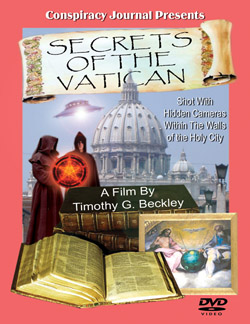|
 In Association With
Mysteries
Magazine!
In Association With
Mysteries
Magazine!
2/16/07 #404
http://www.conspiracyjournal.com
Subscribe for free at our subscription page:
http://www.members.tripod.com/uforeview/subscribe.html
You can view this newsletter online at:
https://uforeview.tripod.com/conspiracyjournal404.html
High overhead, the black
helicopter hovered soundlessly. Inside, secret high-tech monitoring
equipment recorded anything that looked suspicious -- and to them,
everything is suspicious! The simplest phone calls, the most innocent
of e-mails, the junkiest of junk mails, all raise flags of warning to
those who listen. To them, freedom means subversion. Privacy means
treason. Innocence means guilt. They watch and wait, for soon
will come the time when once again, e-mail boxes all across the planet
are filled with your number one source of information on conspiracies,
UFO, the paranormal, and much more - Conspiracy Journal!
This
week Conspiracy Journal takes a look at such awe-inspiring stories as:
- Chilean Army Reveals Recordings, Secret UFO
Contacts -
-
The Brain Scan That Can
Read People's Intentions -
- Ancient Chimps "Used Stone Tools"
-
AND: Black Dogs and UFOs
All these exciting stories and MORE
in this week's issue of
CONSPIRACY JOURNAL!
~ And Now, On With The Show! ~

NEW
FROM CONSPIRACY JOURNAL FILMS
FIND OUT WHAT MYSTERIES AND
CONSPIRACIES
THE VATICAN HAS BEEN HIDING FOR CENTURIES!
New on DVD -
SECRETS OF THE VATICAN

SHOT
WITHIN THE WALLS OF THE HOLY CITY WITH HIDDEN CAMERAS The Vatican has
been shrouded in mystery and intrigue for centuries. Except for the
highest Cardinals and Bishops, the public and even members of the
priesthood are not privy to the inner workings of the Church. It is
rumored that there are in the secret archives centuries-old artifacts
that, if exposed, could embarrass the standard-bearers of the faith.
Searching for truth has always been the Conspiracy Journal's main goal.
With this in mind, we recently "invaded" the walls of the Vatican with
our hidden cameras on a fact finding mission. On our return, we
followed up our investigation by interviewing such astute researchers
as: Jordan Maxwell - Brad Steiger - Patricia Ress - Penny Melis - and Diane Tessman.
SOME OF
THE EXCITING CONTENTS IN THIS DVD VIDEO INCLUDE:
* Does the Vatican conceal
knowledge that the crucifixion was a fraud?
* Is there a secret cabal
of Satanists within the Vatican to further the evil conspiracy of the
New World Order?
* Learn about
the UFO sighting that occurred over the Vatican the morning of the
funeral of Pope John Paul.
* Can
exorcism be a futile effort that often results in the death of the
possessed?
* What
secrets is the Vatican keeping about the perilous future of our world?
* Is the
Vatican link to the Hubble Telescope evidence that they are aware that
Planet X is headed toward Earth?
SPECIAL BONUS OFFER - If you act
right now, you will also get the FREE
unedited audio interviews with Brad Steiger, Jordan Maxwell, Patricia
Ress, and noted psychic Penny Melis. These interviews were conducted by
Sean Casteel for use in the documentary. However, as with every
documentary, only a small portion of each interview ever makes it to
the screen. Now you can hear the complete, unedited interviews as each
researcher reveals what they know concerning the secrets of the
Vatican.
This controversial
documentary is now available
for the incredible price of only $15.00 plus $5.00 shipping
Along with the DVD you can also
get for A LIMITED TIME only, Arthur Crockett's
sensational book - SECRETS OF THE POPES - Both
the DVD and the book for only
$27.00
plus $5.00 shipping.
Please
Specify Video Format - DVD or VHS
You can order online via our
secure order page:
CLICK
HERE TO ORDER
(https://www.anadynesystems.com/client/fhtml20050304164122187002.htm)
You can also phone in your
credit card orders to Global Communications
24-hour hotline: 732-602-3407
And as always you can send a
check or money order to:
Global Communications
P.O. Box 753
New Brunswick, NJ 08903

Thursdays
at 5:00 PM EST at www.7thWaveNetwork.com
Timothy Green Beckley (Mr. UFO) on Out There TV
Watch our good friend Timothy Green Beckley on Out There TV where he talks about the
mysteries and possibilities of the hollow Earth and other strange and
weird mysteries.
This is a show not to be missed! You can now see it online at:
http://www.lvitv.com/OutThereTV/playflash.php?v_id=245&state=flash
-
UFO SECRETS REVEALED DEPARTMENT -
Chilean Army Reveals
Recordings, Secret UFO Contacts
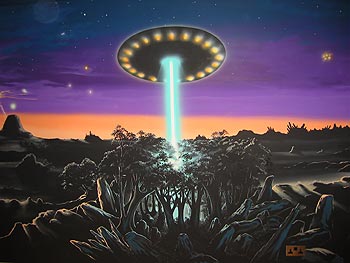
Santiago de Chile - The evidence was presented before one thousand
people at the 10th International UFO Congress, which highlighted a
video taken seven years ago, showing moments in which Navy vessels and
helicopters pursue a UFO that was even picked up on radar.
The Chilean Army revealed to the UFO community classified material
regarding recordings and encounters between the military and UFOs over
the past 30 years, according to the El Mercurio newspaper.
The evidence was presented at the 10th International UFO Congress,
highlighting the display of a video that captures a UFO pursuit by
surface vessels and helicopters of the Chilean Navy seven years ago,
according to Rodrigo Fuenzalida, director of the Agrupacio de
Investigaciones Ovnilogicas (AION).
Another pursuit took place on March 27, 2000 when a Citation-2 military
aircraft crossed an unidentified flying object, measuring 40 meters in
length, at an altitude of 1000 meters and 100 kilometers away from the
Chilean capital.
Disclosure of this information was authorized by Oscar Izurieta,
Commander in Chief of the Armed Forces, and forms part of an official
investigation undertaken by Rodrigo Bravo, captain of the Army's 5th
Division, who participates in the congress, which was held at the
Viña del Mar resort 120 kilometers distant from Santiago de
Chile.
The military photographs and videos included a photograph of a
spherical metallic object captured flying over Antarctica and a video
of Navy ships being pursued by a luminous object in 2000.
Captain Bravo talked to a rapt audience about his thesis, entitled
"Observations of unidentified aerial phenomena identified by the Civil
Air Force." While Bravo’s talk was not technically representative of
the institution’s position on UFOs, he had been authorized to give it
by his commander-in-chief.
"Captain Bravo gave his talk from the point of view of the importance
of UFOs as a phenomenon," said Fuenzalida. "He talked about encounters
such as that of three helicopters near La Unión, when a UFO was
spotted parked on the ground, and what happened in 2000, when five
people were pursued by a luminous object that did not show up on radar
screens."
Fuenzalida denied the existence of "secret investigations" being
carried out by the Armed Forces about extraterrestrial activity.
Also present at the conference was retired official Armando
Valdés, who is noted for his involvement in one of Chile’s first
documented UFO abductions, which became known as the Valdés
Case. On April 25, 1977, Valdés, along with five members of an
army patrol, saw two bright objects descending from the sky.
Valdés set out alone to investigate and, according to the men,
simply vanished. Fifteen minutes later, they said, he reappeared, tried
to speak and passed out. The date on his watch had been advanced five
days, and he had about a week's growth of beard.
According to his comrades, when Valdes was beginning to regain
consciousness he said: "You do not know who we are, nor where we come
from. But I tell you that we will soon return."
From Scott Corrales Inexplicata -The Journal of Hispanic Ufology
Source: Diario Milenio/The Santiago Times
- SEARCH FOR THE TRUTH MUST GO ON
DEPARTMENT -
A Princeton Lab on ESP Plans to Close Its Doors
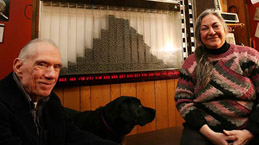
Over almost three decades, a
small laboratory at Princeton University managed to embarrass
university administrators, outrage Nobel laureates, entice the support
of philanthropists and make headlines around the world with its efforts
to prove that thoughts can alter the course of events.
But at the end of the month, the Princeton Engineering Anomalies
Research laboratory, or PEAR, will close, not because of controversy
but because, its founder says, it is time.
The laboratory has conducted studies on extrasensory perception and
telekinesis from its cramped quarters in the basement of the
university’s engineering building since 1979. Its equipment is aging,
its finances dwindling.
“For 28 years, we’ve done what we wanted to do, and there’s no reason
to stay and generate more of the same data,” said the laboratory’s
founder, Robert G. Jahn, 76, former dean of Princeton’s engineering
school and an emeritus professor. “If people don’t believe us after all
the results we’ve produced, then they never will.”
Princeton made no official comment.
The closing will end one of the strangest tales in modern science, or
science fiction, depending on one’s point of view. The laboratory has
long had a strained relationship with the university. Many scientists
have been openly dismissive of it.
“It’s been an embarrassment to science, and I think an embarrassment
for Princeton,” said Robert L. Park, a University of Maryland physicist
who is the author of “Voodoo Science: The Road From Foolishness to
Fraud.” “Science has a substantial amount of credibility, but this is
the kind of thing that squanders it.”
PEAR has been an anomaly from the start, a ghost in the machine room of
physical science that was never acknowledged as substantial and yet
never entirely banished. Its longevity illustrates the strength and
limitations of scientific peer review, the process by which researchers
appraise one another’s work.
“We know people have ideas beyond the mainstream,” said the sociologist
Harriet Zuckerman, author of “Scientific Elite: Nobel Laureates in the
United States” and senior vice president of the Andrew W. Mellon
Foundation, ”but if they want funds for research they have to go
through peer review, and the system is going to be very skeptical of
ideas that are inconsistent with what is already known.”
Dr. Jahn, one of the world’s foremost experts on jet propulsion, defied
the system. He relied not on university or government money but on
private donations — more than $10 million over the years, he estimated.
The first and most generous donor was his friend James S. McDonnell, a
founder of the McDonnell Douglas Corporation.
Those gifts paid for a small staff and a gallery of random-motion
machines, including a pendulum with a lighted crystal at the end; a
giant, wall-mounted pachinko-like machine with a cascade of bouncing
balls; and a variety of electronic boxes with digital number displays.
In one of PEAR’s standard experiments, the study participant would sit
in front of an electronic box the size of a toaster oven, which flashed
a random series of numbers just above and just below 100. Staff members
instructed the person to simply “think high” or “think low” and watch
the display. After thousands of repetitions — the equivalent of coin
flips — the researchers looked for differences between the machine’s
output and random chance.
Analyzing data from such trials, the PEAR team concluded that people
could alter the behavior of these machines very slightly, changing
about 2 or 3 flips out of 10,000. If the human mind could alter the
behavior of such a machine, Dr. Jahn argued, then thought could bring
about changes in many other areas of life — helping to heal disease,
for instance, in oneself and others.
This kind of talk fascinated the public and attracted the curiosity of
dozens of students, at Princeton and elsewhere. But it left most
scientists cold. A physics Ph.D. and an electrical engineer joined Dr.
Jahn’s project, but none of the university’s 700 or so professors did.
Prominent research journals declined to accept papers from PEAR. One
editor famously told Dr. Jahn that he would consider a paper “if you
can telepathically communicate it to me.”
Brenda Dunne, a developmental psychologist, has managed the laboratory
since it opened and has been a co-author of many of its study papers.
“We submitted our data for review to very good journals,” Ms. Dunne
said, “but no one would review it. We have been very open with our
data. But how do you get peer review when you don’t have peers?”
Several expert panels examined PEAR’s methods over the years, looking
for irregularities, but did not find sufficient reasons to interrupt
the work. In the 1980s and 1990s, PEAR published more than 60 research
reports, most appearing in the journal of the Society for Scientific
Exploration, a group devoted to the study of topics outside the
scientific mainstream. Dr. Jahn and Ms. Dunne are officers in the
society.
News of the Princeton group’s experiments spread quickly worldwide,
among people interested in paranormal phenomena, including telekinesis
and what people call extrasensory perception. Notable figures from
Europe and Asia stopped by. . Keith Jarrett, the jazz pianist, paid a
visit. For a time, the philanthropist Laurance Rockefeller visited
regularly and donated money for research.
And many people, in and out of science, joined what Ms. Dunne called
the PEAR Tree, a kind of secret society of people interested in the
paranormal, she said. Many PEAR Tree members who are science faculty
members will not reveal themselves publicly, Ms. Dunne said.
The culture of science, at its purest, is one of freedom in which any
idea can be tested regardless of how far-fetched it might seem.
“I don’t believe in anything Bob is doing, but I support his right to
do it,” said Will Happer, a professor of physics at Princeton.
Other top-flight scientists have taken chances. At the end of his
career, Linus Pauling, the Nobel laureate, came to believe that vitamin
C supplements could prevent and treat cancer, heart disease and other
ailments. Dr. Pauling had some outside financing, too, and conducted
research and had plenty of media coverage. But in the end he did not
sway many of his colleagues, Dr. Zuckerman said.
At the PEAR offices this week, the staff worked amid boxes, piles of
paper and a roll of bubble wrap as big as an oil drum. The random-event
machines are headed for storage.
The study of telekinesis and related phenomena, Dr. Jahn said, will
carry on.
“It’s time for a new era,” he said, “for someone to figure out what the
implications of our results are for human culture, for future study,
and — if the findings are correct — what they say about our basic
scientific attitude.”
Source: NY Times
http://www.nytimes.com/2007/02/10/science/10princeton.html?_r=2&oref=slogin&oref=slogin
-
I KNOW WHAT YOU ARE GOING TO DO DEPARTMENT -
The Brain Scan That Can
Read People's Intentions
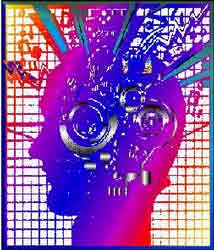
Call for ethical debate over possible use of new technology in
interrogation.
Using the technology is 'like shining a torch, looking for writing on a
wall'. CT image: Charles O'Rear/Corbis
A team of world-leading neuroscientists has developed a powerful
technique that allows them to look deep inside a person's brain and
read their intentions before they act.
The research breaks controversial new ground in scientists' ability to
probe people's minds and eavesdrop on their thoughts, and raises
serious ethical issues over how brain-reading technology may be used in
the future.
The team used high-resolution brain scans to identify patterns of
activity before translating them into meaningful thoughts, revealing
what a person planned to do in the near future. It is the first time
scientists have succeeded in reading intentions in this way.
"Using the scanner, we could look around the brain for this information
and read out something that from the outside there's no way you could
possibly tell is in there. It's like shining a torch around, looking
for writing on a wall," said John-Dylan Haynes at the Max Planck
Institute for Human Cognitive and Brain Sciences in Germany, who led
the study with colleagues at University College London and Oxford
University.
The research builds on a series of recent studies in which brain
imaging has been used to identify tell-tale activity linked to lying,
violent behaviour and racial prejudice.
The latest work reveals the dramatic pace at which neuroscience is
progressing, prompting the researchers to call for an urgent debate
into the ethical issues surrounding future uses for the technology. If
brain-reading can be refined, it could quickly be adopted to assist
interrogations of criminals and terrorists, and even usher in a
"Minority Report" era (as portrayed in the Steven Spielberg science
fiction film of that name), where judgments are handed down before the
law is broken on the strength of an incriminating brain scan.
"These techniques are emerging and we need an ethical debate about the
implications, so that one day we're not surprised and overwhelmed and
caught on the wrong foot by what they can do. These things are going to
come to us in the next few years and we should really be prepared,"
Professor Haynes told the Guardian.
The use of brain scanners to judge whether people are likely to commit
crimes is a contentious issue that society should tackle now, according
to Prof Haynes. "We see the danger that this might become compulsory
one day, but we have to be aware that if we prohibit it, we are also
denying people who aren't going to commit any crime the possibility of
proving their innocence."
During the study, the researchers asked volunteers to decide whether to
add or subtract two numbers they were later shown on a screen.
Before the numbers flashed up, they were given a brain scan using a
technique called functional magnetic imaging resonance. The researchers
then used a software that had been designed to spot subtle differences
in brain activity to predict the person's intentions with 70% accuracy.
The study revealed signatures of activity in a marble-sized part of the
brain called the medial prefrontal cortex that changed when a person
intended to add the numbers or subtract them.
Because brains differ so much, the scientists need a good idea of what
a person's brain activity looks like when they are thinking something
to be able to spot it in a scan, but researchers are already devising
ways of deducing what patterns are associated with different thoughts.
Barbara Sahakian, a professor of neuro-psychology at Cambridge
University, said the rapid advances in neuroscience had forced
scientists in the field to set up their own neuroethics society late
last year to consider the ramifications of their research.
"Do we want to become a 'Minority Report' society where we're
preventing crimes that might not happen?," she asked. "For some of
these techniques, it's just a matter of time. It is just another new
technology that society has to come to terms with and use for the good,
but we should discuss and debate it now because what we don't want is
for it to leak into use in court willy nilly without people having
thought about the consequences.
"A lot of neuroscientists in the field are very cautious and say we
can't talk about reading individuals' minds, and right now that is very
true, but we're moving ahead so rapidly, it's not going to be that long
before we will be able to tell whether someone's making up a story, or
whether someone intended to do a crime with a certain degree of
certainty."
Professor Colin Blakemore, a neuroscientist and director of the Medical
Research Council, said: "We shouldn't go overboard about the power of
these techniques at the moment, but what you can be absolutely sure of
is that these will continue to roll out and we will have more and more
ability to probe people's intentions, minds, background thoughts, hopes
and emotions.
"Some of that is extremely desirable, because it will help with
diagnosis, education and so on, but we need to be thinking the ethical
issues through. It adds a whole new gloss to personal medical data and
how it might be used."
The technology could also drive advances in brain-controlled computers
and machinery to boost the quality of life for disabled people. Being
able to read thoughts as they arise in a person's mind could lead to
computers that allow people to operate email and the internet using
thought alone, and write with word processors that can predict which
word or sentence you want to type . The technology is also expected to
lead to improvements in thought-controlled wheelchairs and artificial
limbs that respond when a person imagines moving.
"You can imagine how tedious it is if you want to write a letter by
using a cursor to pick out letters on a screen," said Prof Haynes. "It
would be much better if you thought, 'I want to reply to this email',
or, 'I'm thinking this word', and the computer can read that and
understand what you want to do."
Source: The Guardian
http://www.guardian.co.uk/frontpage/story/0,,2009229,00.html
-
VIEWS FROM ON HIGH DEPARTMENT -
Astronauts Experiences with
UFOs
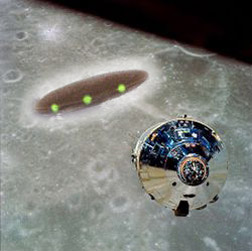
Unexplained aerial phenomena have been reported over the years by many
intelligent and credible people, including police officers, scientists,
astronomers, military personnel, pilots, and even astronauts.
For instance, during the first American orbital flight in February,
1962, astronaut John Glenn, piloting the Mercury capsule, saw three
objects follow and then overtake him at varying speeds. Glenn then
observed what he called glowing "snowflakes" or "fireflies" that
swirled around his capsule. NASA officials surmised that the fireflies
were bits of ice that had become detached from the sides of the
capsule.
Later Mercury astronauts also reported the same phenomena, radioing
back to NASA that more "fireflies" could be produced when they
tapped on the side of the capsule.
Three years later, in June, 1965, astronaut James McDivitt on Gemini 4
photographed and filmed a cylindrical-shaped object with an
antenna-like extension. McDivitt said the object was silvery in
appearance and was approximately ten miles away. "It looked like a beer
can with a pencil sticking out of it at an angle," McDivitt described.
After splashdown, the film was sent from the carrier to be processed.
When the NASA photo interpreter released three or four pictures of the
UFO, a few days later, McDivitt stated that the quality of the photo
was so bad that it failed to reproduce what he had seen.
NORAD suggested that the object might have been a satellite called
Pegasus which was 1,200 miles away at the time, even though the object
McDivitt had sighted appeared to be much closer.
Then during December's Gemini 7 flight, astronauts Jim Lovell and Frank
Borman radioed Mission Control that they had a "bogey" in sight as well
as many illuminated particles. NASA suggested that the bogey and
particles were fragments from the launching of Gemini 7, but this is
impossible if they were traveling in a different orbit from Gemini 7,
as the astronauts described.
In 1966, during the flight of Gemini 10, two red glowing objects
captured the attention of astronauts John Young and Michael Collins as
they circled the Earth. They had ventured further into space than any
other human at the time, and suddenly both astronauts were amazed to
see that two glowing objects now occupied the same orbital path as
themselves.
The official verdict attributed the objects to space junk discarded
from an unmanned Saturn rocket that had been launched earlier that
month. But the astronauts were adamant these were not stars and it is
difficult to imagine how a manmade device could maneuver in the erratic
way the objects did when they suddenly left orbit and quickly
disappeared from sight.
Code Word Santa Claus
Because of the unwanted media attention generated by the Gemini UFO
reports, NASA instructed its astronauts to never use words such as
"bogey" or "UFO" if they sighted something unidentified. Instead, they
were to use the code-word "Santa Claus" when informing Mission Control
of unusual activity around their capsules. Additionally, Mission
Control stopped allowing the networks to hear live broadcasts from the
astronauts. Instead, they initiated a five-second tape delay, possibly
to quickly prevent astronauts from accidentally broadcasting any
unexpected UFO encounters.
This edict came just in time for the Apollo missions to the moon, where
both astronauts Neil Armstrong and Edwin Aldrin supposedly saw UFOs
shortly after their historic landing on the moon in July, 1969.
According to former NASA employee Otto Binder, unnamed radio hams who
bypassed NASA's broadcasting outlets picked up this message from Apollo
11: "These babies are huge sir...enormous...oh, God, you wouldn't
believe it! I'm telling you there are other spacecraft out
there...lined up on the far side of the crater edge...they're on the
moon watching us."
These stories were repeated in various UFO magazines, but it was not
verified until 1979, when Maurice Chatelain, senior engineer for NASA
contractor North American Aviation, confirmed that Armstrong had indeed
reported seeing two UFOs on the rim of a crater.
"The encounter was common knowledge in NASA. In fact, all Apollo and
Gemini flights were followed by space vehicles of unknown origin.
Every time it occurred, the astronauts informed Mission Control, who
then ordered absolute silence."
The late astronaut Leroy Gordon "Gordo" Cooper Jr. said in 2000 that
the government "swept under the rug" the truth about unidentified
flying objects.
One reason why Cooper was so insistent that UFOs are real was his own
personal sightings in the 1950s while assigned to a jet fighter group
in Germany. While stationed there in 1952, formations of
metallic-looking circular objects passed over the Air Base on an almost
daily basis.
UFOs continued to haunt Cooper when he was transferred several years
later to Edwards Air Force Base Flight Test Center in the California
desert. In 1957, he was one of an elite band of test pilots in charge
of several advanced projects, including the installation of a precision
landing system. He had a camera crew filming the installation
when they spotted a flying saucer. They filmed it as it flew overhead,
then hovered, extended three legs as landing gear, and slowly came down
to land on a dry lake bed.
The camera crew managed to get within 20 or 30 yards of the landed
disc, filming all the time. It was a classic saucer, shiny silver
and smooth, and about 30 feet across. As they approached, it took off
and disappeared into the clear sky.
After the footage was forwarded to Washington, the movie "vanished,"
never to surface again. When the Air Force later started
Operation Blue Book in 1952 to collate UFO evidence and reports,
Cooper says he mentioned the film evidence, but the film was
supposedly never found.
Rumors persist that American astronauts and Russian cosmonauts continue
to see UFOs while in space. As many of NASA's programs are funded by
the Department of Defense, most astronauts are subject to military
security regulations and are forbidden to publicly speak about their
sightings.
Hopefully, as time goes by and more astronauts retire, they will choose
to publicly discuss their UFO encounters. Only then will the public get
a better idea of the kinds of strange mysteries that await us in the
deep, dark reaches of outer space.
Source: Tim Swartz/Mysteries Magazine
-
RENAISSANCE AGE FOR CHIMPS DEPARTMENT -
Ancient Chimps "Used Stone
Tools"
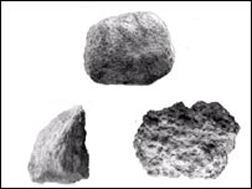
Chimpanzees in West Africa used stone tools to crack nuts 4,300 years
ago. The discovery represents the oldest evidence of tool use by our
closest evolutionary relative.
The first prehistoric evidence for a "chimpanzee stone age" has been
uncovered by archaeologists working in an African rainforest. Primitive
stone hammers and anvils dating from 4,300 years ago were excavated
from pits at three sites in the Taï national park in Ivory Coast.
The tools, used to crush and crack food, are too large for humans to
have wielded with ease, and showed traces of starch from varieties of
nuts that were staples of the chimp diet, but avoided by humans.
The skill could have been inherited from a common ancestor of chimps
and humans, the authors say, or learnt from humans by imitation.
Alternatively, humans and chimps may have developed tool use
independently, the Proceedings of the National Academy of Sciences
journal reports.
Chimpanzees were first observed using stone tools in the 19th century.
Julio Mercader from the University of Calgary and colleagues found
stone tools at the Noulo site in Ivory Coast, the only known
prehistoric chimpanzee settlement. The excavated stones showed the
hallmarks of use as tools for smashing nuts when compared with ancient
human or modern chimpanzee stone tools.
"Chimpanzee material culture has a long prehistory whose deep roots are
only beginning to be uncovered," write the researchers in Proceedings.
The discovery suggests that from ancient times chimpanzees used
rudimentary technology and handed the skills down to later generations.
The flood plain where the stone fragments were uncovered was not widely
occupied by humans at the time, leading the researchers to suspect that
early tool use was not learned from humans, but may have been passed on
to chimps and humans alike from a more primitive ancestor.
"It's not clear whether we invented this kind of stone technology, or
whether both humans and great apes inherited it from a common
forebear," said Mercader. "There weren't any farmers living in this
region 4,300 years ago, so it's unlikely the chimpanzees picked it up
by imitating villagers."
He added: "We used to think that culture and, above anything else,
technology was the exclusive domain of humans, but this is not the
case."
The age of the tools was determined by subjecting charcoal from the
same ground layers to the technique of radiocarbon dating.
Huw Barton, a co-author on the study at Leicester University, said the
finding raised the tantalising suggestion that tool use among
chimpanzees may have progressed, at least for a while, in parallel with
human usage.
"At the moment, we know for chimpanzees tool use goes back at least
4,300 years, but what if it goes back much further? Who knows what we'd
find."
Source: BBC
http://news.bbc.co.uk/2/hi/science/nature/6356773.stm
-
THINGS THAT GO BUMP IN THE NIGHT DEPARTMENT -
Black Dogs and UFOs
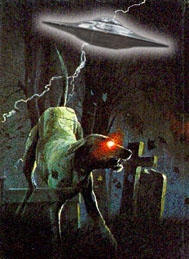
Three weeks ago a fascinating story was related to me by a colleague
from my old home county of Staffordshire, England. “You’re not going to
believe this one,” he told me excitedly down the phone. Well, I’ve
heard some bizarre things in my time as an investigator of all-things
weird, and so I sat back and listened to his story - that was provided
to him by the person directly involved.
Essentially, the story centers upon a 1991 encounter with the unknown
at a place called Castle Ring, which at 801 feet above sea-level is the
highest point on a large area of forest in central England called the
Cannock Chase. A plateau bordered by the Trent Valley to the north and
the West Midlands to the south, the Chase is situated only several
miles from where I grew up; and it is a beautiful, expansive area full
of dense woods, a variety of wild animals, and magical tales of mystery
and wonder.
Indeed, the area has a rich and long history of reported encounters
with Bigfoot, UFOs, ghosts, big cats and even the occasional wallaby.
It has also been the site of a number of disturbing animal mutilations
that have been linked with occult activities.
Built between 500 BC and AD 40, Castle Ring is an Iron Age structure
commonly known as a Hill Fort. Its main ditch and bank enclosure is 14
feet high and, at its widest point, is 853 feet across. Little is known
about the people who built Castle Ring or its purpose, except to say
that its creators were already in residence at the time of the Roman
invasion and remained there until around AD 50.
But back to the story, which involves a historian and folklorist who
lives in the English city of Lichfield. It is the historian’s belief
that all of the weird activity that has occurred on the Cannock Chase -
whether it be encounters of the alleged Bigfoot kind or ET kind - is a
direct result of people dabbling in archaic rituals and rites designed
to conjure up the denizens of some netherworld that co-exists with ours.
Such claims are not new, and having experienced more than a bit of
high-strangeness myself on the Cannock Chase, I am highly inclined to
believe that such a scenario is indeed the correct one. And it seems
that the historian has good reasons for coming to such conclusions.
It was December 1991, around 10.00 AM on a cold winter morning, and the
historian was walking around the Castle Ring, taking photographs, when
his attention was drawn to a small, dense - and “hovering” - area of
fog situated at a distance of about 250 to 300 feet. Curious as to what
would cause such a phenomenon, he headed towards it, with some
trepidation, he admitted. As he got within about 20 feet of the fog, he
felt his hair become “static and electrified,” and an intense smell of
burning metal filled the air: brimstone, no less.
But the bizarre activity had barely begun: suddenly, out of the fog
loomed a large, and certainly monstrous, black dog. According to the
historian, the dog looked in appearance like a cross between an
Alsatian (or, for American readers, a German Shepherd) and a Pit-Bull,
but was around the size of “a young horse.” The man detected an air of
menace from the creature, which, he said, seemed to be “vibrating at a
very high speed, like shaking impossibly quickly.” It positively oozed
menace, and stamped its leg on the ground “like a bull would when it’s
getting ready to charge.”
The man slowly backed away, and the black dog did likewise, retreating
into the impenetrable depths of the fog. As the man reached a point
perhaps 150 feet from the fog, he was both startled and shocked to see
a small ball of light “zoom in” over the fog and duly cast down a vivid
blue column of light in its direction. In an instant, the fog and the
ball of light were gone, the black dog was nowhere to be seen, and
normality was restored.
So, we might well ask: what on earth was all that about? Well, Britain
has a long history and tradition of encounters with such black dogs. In
centuries past they plagued the countryside, and to see one was
considered an ill-omen, indeed. Death, disaster and untold tragedy were
all said to follow an encounter with these spectral beasts. With names
like Old Shuck, Black Shuck, and the Shug Monkey, they struck terror
into the hearts of the people of Britain during the Middle Ages.
Occasionally and curiously, however, the black dogs would act as guides
for lost souls, directing them back to the safety of ancient pathways
and roads, or direct them away from danger. But whatever they were, the
black dogs were certainly nothing normal.
Today, encounters with such creatures are reported very infrequently,
but they do occur - such as this one at the Castle Ring in 1991. Then,
of course, we have the strange, aerial ball of light present at the
Ring, that adds significant UFO overtones to the story. Can the whole
weird saga be resolved? The historian believes it can.
Indeed, he is of the firm opinion that ancient man - who certainly
constructed the Castle Ring - had mental abilities that extended far
beyond our own, and was able to essentially tap into other realms of
existence, and construct “from the mind” images of bizarre and
monstrous beasts that inhabited those same realms.
The purpose? To act as guardians to prevent any harm being done to the
areas that ancient man deemed to be of spiritual significance. It is
the historian’s belief that some of the residual energy that led to the
creation of these wild images is still in place at Castle Ring and
elsewhere; and that when the time is right, they will once again
manifest and take up their role as both guardian and protector of the
old world.
I had come to similar conclusions myself a number of years ago. Of
course, this raises deep and important questions about both Ufology and
Cryptozoology, such as: how many of the still-elusive things that we
pursue are flesh-and-blood entities, and how many may - in reality -
originate in realms far stranger than we can possibly imagine?
Certainly, the Cannock Chase has been the site of a number of
Bigfoot-style encounters that have distinctly paranormal aspects to
them, and that have occurred in the exact same locations where
significant UFO activity has also been reported.
Needless to say, such observations have been made for decades by
authorities such as John Keel. But, as this case serves to emphasize,
whoever was responsible for those centuries old reports of ghostly
black dogs, they were still up to their bizarre tricks deep in the
heart of Castle Ring only 16 years ago.
Next time you visit a prehistoric site, keep one eye on the sky and one
on the ground. If you’re lucky, you may see something far stranger than
mere ancient, standing stones…
Source: UFOMystic
http://www.ufomystic.com/the-redfern-files/black-dogs-and-ufos/
SUPPRESSED SCIENCE - FREE ENERGY
- ANTIGRAVITY
Tesla's Secret Lab -
www.teslasecretlab.com
Articles - Information - Amazing Books and Products - Including
Tesla Purple Energy Plates!
All Tesla - All The Time At Tesla's Secret Lab - Drop by for a
visit Today! - http://www.teslasecretlab.com
MYSTERIES MAGAZINE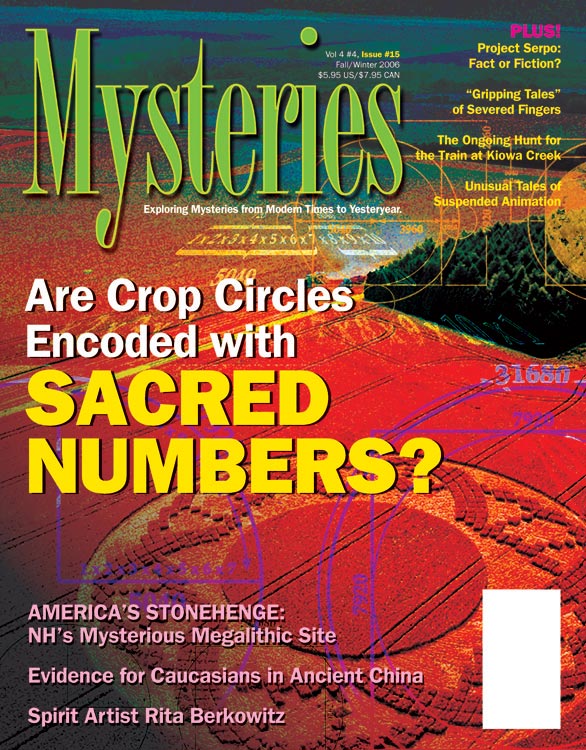
It's Time to
Question Your Beliefs!
If you have a
voracious appetite for stories of lost treasure, are
fascinated by the occult, or savor tales of the unexplained,
conspiracies, and other strange stories of the weird world we live in,
then Mysteries
Magazine is for you.
|



